Thursday, 27 August 2015: To Salamanca and back again
Written 23 December 2015
Early breakfast this morning, then into the buses for the trip to Salamanca, a little more than an hour and a half east, in Spain. As usual, abundant information was imparted on the way.
- Portugal joined the European Union in 1986.
- Rail travel has been interrupted between Porto and Salamanca for quite a while, but they're talking about restoring it.
- Spain has 50 million inhabitants. It is eight times the size of Portugal, but its population is only five times larger. (How does that jibe with what they told us earlier? I'm pretty sure they said Portugal is the least densely populated country in the EU . . .)
- Philipe VI, son of Juan Carlos, is currently king of spain, in a constitutional monarchy. Juan Carlos apparently abdicated after a series of scandals. The Spanish speak mostly Castillian and, in the northwest, Gallician. Portuguese is much more mutually intelligible with Gallician than with Castillian. Other Spanish languages are Catalan, Basque, and, in the southern part, Valenciano.
- La Fregeneda (which we passed through coming and going) is where Wellesley (who became Lord Wellington) camped most of the time during the peninsular wars.
- Philipe I, II, and III were the rulers during interruption. Philipe I wasn't bad; II and III were. Portugal still resents not just the interruption but also the permission Spain gave to France to come through to attack Portugal under Napoleon.
- Spain is an hour ahead of Portugal because Franco wanted to be in the same time zone as Hitler's germany, so he changed it, and nobody has changed it back. Portugal is on Greenwich Mean Time. (We were advised not to change our watches, because Viking intended to conduct the whole trip on Portuguese time; that's how all the events on our program were set up.)
- Paella was invented by Franco; he wanted a dish that had the colors of the Spanish flag, would serve as a national symbol, and would draw tourist. As I pointed out in an earlier travel diary, though, the true national dish of Spain is ham.
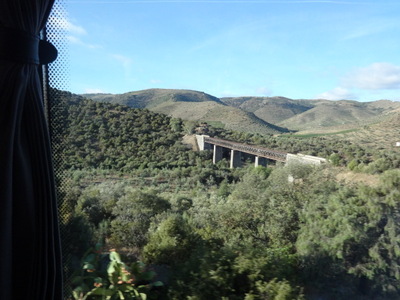
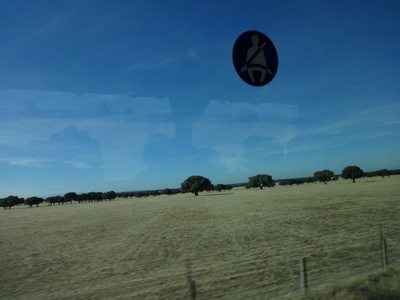 We passed this railway bridge as we left the river, but by the time we were half an hour into Spain, we saw no more olives or almonds, just pasture-land with a few scattered oaks (as shown at the right; the fields were level; only the camera was tilted), recently harvested hay fields, and some plowed fields. The land was a high, flat pleateau.
We passed this railway bridge as we left the river, but by the time we were half an hour into Spain, we saw no more olives or almonds, just pasture-land with a few scattered oaks (as shown at the right; the fields were level; only the camera was tilted), recently harvested hay fields, and some plowed fields. The land was a high, flat pleateau.
We passed through many small settlements, each with a few businesses (one alfalfa company; some places labeled "Meubles," which in French would mean furniture; cement factories; one cheese factory). I saw cattle (white, red, particolored, shades in between, and a few black), a few of the famous black pigs used to make the ham of the region, a few vines. Plantings of small umbrella pines along fence rows. A herd of sheep followed by a man on a gray horse. Mostly, though, the land was deserted—livestock was very sparse. The cattle had horns and half-grown calves. More of them were visible during the return trip than on our way out.
La Fregeneda and many other villages seem to have their own solar farms! One cement factory we passed had shaded parking for the employees, and they had solar panels on the shades! (Or maybe they had a solar farm and decided to let employees park under the panels.)
In one small town, I spotted a group of used parade floats, including one with Asterix and Obelix on it. In another, I saw a small local stadium, maybe a bull ring.
We'd been warned to watch for red kites in the area, and sure enough, in the course of our round trip, I saw four or five of them, flying or hovering over the neighboring fields. Another new one for my life list. I also spotted swallows with dirty white breasts and black throats. (I haven't heard a single house martin this whole trip!) Stork nests on an electrical line and and overhead water duct were pointed out to us. The storks themselves will be back in late April
The countryside was crisscrossed with many dry stone walls, some of which you could see through, made of flat or columnar chunks of schist (lighter colored than slate) or slate, often stacked diagonally or herringbone.
As we got farther into Spain, the towns began to advertise "jamon iberico," Iberian ham, and one advertised "honey and pollen."
Written 17 March 2016
(It's been a busy spring. Since I last worked on this diary, we've done our usual holiday travel; closed on our new house at Westminster Oaks; hosted a visit from the Sinnetts, who drove down in their van to help us move into it; unpacked and recombobulated in the new house; readied the old house for sale; sold it—it was on the market about 36 hours—traveled to NYC to see a couple of shows, eat some good meals, and attend niece Julia Fox's solo debut at Carnegie Hall; and traveled on to Portland, ME, for the annual Benthic Ecology Meetings, where, as I write, David is downstairs moderating the session on arctic and deep-sea studies. But I digress . . .)
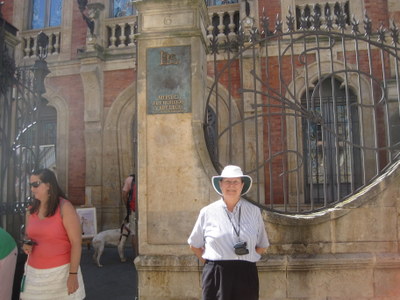
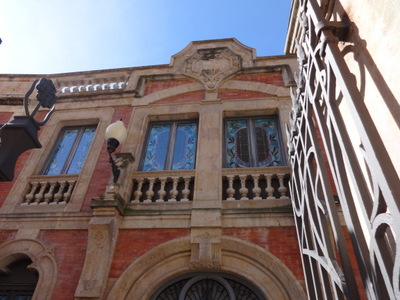 In Salamanca, our free time was before lunch, so we headed for the Lis Museum of Art Nouveau and Art Deco, which was wonderful but was among that annoying class of museums that forbid indoor photography. These shots are the best I could do. A good point is that state-owned museums are free on Thursdays, which is why Viking timed our visit as it did.
In Salamanca, our free time was before lunch, so we headed for the Lis Museum of Art Nouveau and Art Deco, which was wonderful but was among that annoying class of museums that forbid indoor photography. These shots are the best I could do. A good point is that state-owned museums are free on Thursdays, which is why Viking timed our visit as it did.
These two shots show parts of the museum's front gate and façade, with and without me. The windows you can see in the right-hand photo, with art nouveau panels around the edges, are part of the art on display.
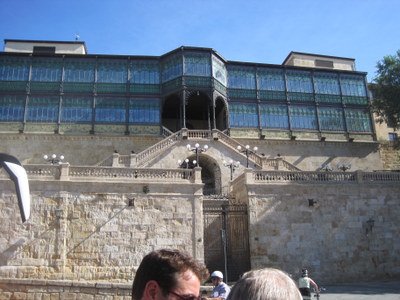
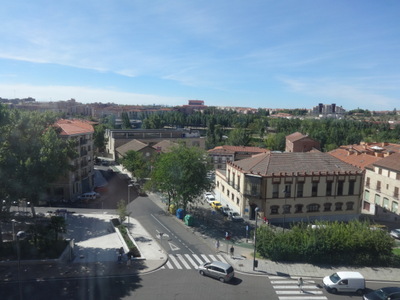 At the left here is the view of the museum from the back, showing another magnificent spread of art nouveau windows.
At the left here is the view of the museum from the back, showing another magnificent spread of art nouveau windows.
On the right is the view from those windows toward the museum we visited next. We were told that, yes, it is permissible to take photos out through the windows but not of anything inside the building.
The museum's holdings were gorgeous. I can take or leave art deco, but I'm a complete sucker for art nouveau, especially art glass, of which they had a lot. You enter through a large central atrium with an art nouveau skylight, and most of the windows have art nouveau trim around the edges (as you can see in the photo of the façade).
What they have most of, though, is small statuary in bronze ("bronce"), ivory ("monfil"), marble ("monmor"), and some onyx, often mixed in the same figure. For example, a dancer's clothing might be of bronze, often painted, and her skin of ivory. Many of the small bronzes were of individual human figures—dancers, bull fighters, nymphs (with 1920s hairstyles), fauns, shepherds, etc. One whole series of such figures were about 18" high, and all were filled with a sense of motion. A collection of tiny miniature painted bronzes included playing kittens, a guy being bitten in the seat of the pants by a crocodile, a heron eating a fish, a pigeon taking flight, an absolutely magnificent little grasshopper. A larger piece portrayed
a guy on a camel shooting a lion that has jumped up on the camel's neck. Another showed Don Quixote and Sancho Panza on horseback.
One whole section was devoted to dolls, all baby dolls, not fashionistas like Barbie; it included only a couple of ethnic costume dolls, still in the baby doll style. Part of it included small 1920s "bathing beauties," some with and some without bathing suits.
An area of toys included soldiers, trucks, a hand-cranked child's sewing machine, and a wind-up metal rowboat.
I found a little Africanesque art tending into the art deco and another section of caracature busts and clowns, some a little rude, and comical heads where the mouths are open, perhaps as ashtrays? One wall sported a largish "painting" reminiscent of Toulouse Lautrec but in colorfully painted glazed porcelain relief.
In the section of furniture was an valkyrie on a horse, both launching themselves forward and upward, very suggestive of fast movement. It actually appeared in two exemplars, of different sizes.
We saw several art deco watches and clocks and a couple of Fabergé things—a letter opener with a clock in it, an egg. Some art deco jewelry and some painted fans, mostly with motifs earlier than art nouveau, I would have thought.
A small collection of lovely inlaid wooden art nouveau furniture included a big art nouveau-cum-art deco dressing stand with mirror and chest of drawers, as well as a magnificent inlaid side table and étagère/vitrine, both by Émile Gallé. Also a gorgeous desk and some École de Nancy furniture: a triangular three-legged service table, a sort of armoire, and a tall clock.
Daum-style vases with flowers and stuff.
What made me drool, though, was the beautiful art nouveau glass work, including many pieces by Lalique, Hermanos Daum, and Émile Gallé (the latter were among the founding members of the École de Nancy, and the work we saw here made me regret more than ever missing the Art Nouveau museum when we were Nancy—we've got to get back there some time).
The Lalique ran largely to perfume bottles, some still partially filled and all specific to brand and scent, though some of the bottles were unattributed, and Crystallerie de Nancy did "Toujours Fidèle" for d'Orsay. I also saw Lalique hood ornaments, a lovely blue Lalique jar with grasshoppers on it, and a "Jarron Donremy" with thistles on it.
The Daum and Gallé jars and vases were fabulous. Most protrayed plants and animals, and the labels identified the plants, complete with Latin binomials, although a few were labeled "unidentified," even though they were easily identifiable and might even appear, properly labled, on another piece a few steps away. I did notice that a couple of the labels on the Daum pieces were switched, misidentifying the plants, but if you could tell a pine tree from a tulip, you could easily figure out which pieces they actually belonged to. I especially liked a lovely little Daum stoppered liqueur pitcher with gorgeous bleeding hearts on it and a large jar by Paul Nicolas from Nancy decorated with pine branches and doves.
Finally, we saw several versions of the usual art nouveau motif of women in stained glass representing the four seasons—in one case spring crocuses, summer poppies, fall grapes, and winter flames.
A lovely museum altogether.
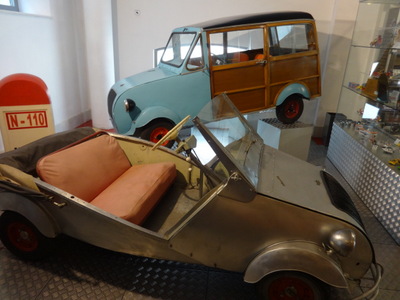
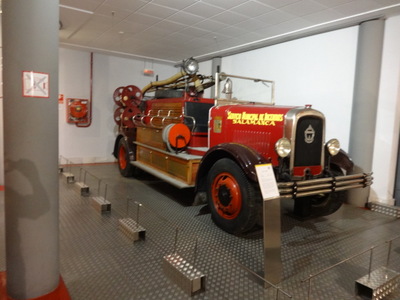 After the Lis museum, we walked down the street you can see in the photo above to the Automobile Museum, which displayed dozens of vehicles like these.
After the Lis museum, we walked down the street you can see in the photo above to the Automobile Museum, which displayed dozens of vehicles like these.
Admission was two euros (it's a private museum), and to our surprise we found we had only two euros between us. I therefore proposed to go to the cathedral while David took the two euros and visited the car museum. I got a few steps back up the block before I turned back to make sure David had a map with him—I was afraid I had our only copy. While I was away, he found the money, in a different pocket, that he thought he'd left on the bus, so we both went to the car museum. Good thing, as the cathedral turned out to charge admission, too, and I couldn't have gotten in.
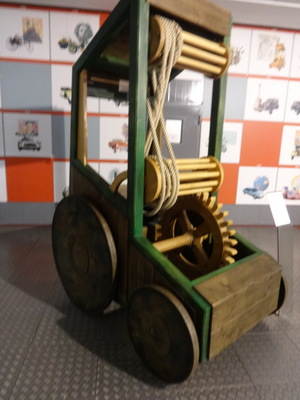
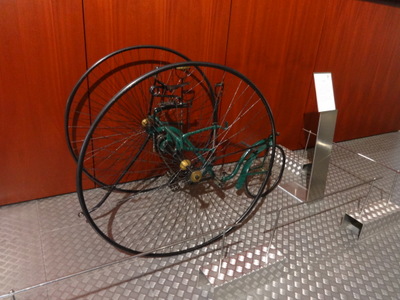 The displays actually started with forerunners of the automobile, like cycles of various sorts. At the left here is a wooden vehicle that the rider powered by turning a wooden crank from the driver's seat that by means of the rope pulleys and gears, turned the wheels. Near it was a small scale model of another wooden vehicle intended to be driven by wind—not by sails but by windmills mounted on the side like paddle-wheels!
The displays actually started with forerunners of the automobile, like cycles of various sorts. At the left here is a wooden vehicle that the rider powered by turning a wooden crank from the driver's seat that by means of the rope pulleys and gears, turned the wheels. Near it was a small scale model of another wooden vehicle intended to be driven by wind—not by sails but by windmills mounted on the side like paddle-wheels!
At the right is an English adult tricycle, pedal-powered like a bicycle. This kind of vehicle was apparently popular for "strolling" along avenues and in parks, as opposed to going somewhere efficiently, as one might do on a serious bicycle.
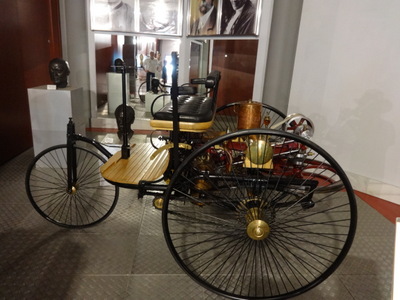
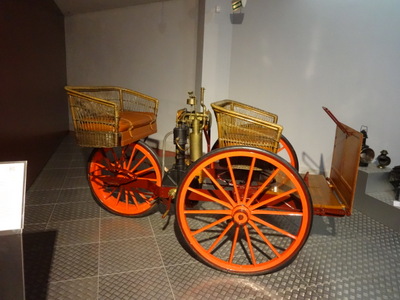 Here are two of the earliest motorized vehicles, a modified tricycle at the left (a Benz, no less) and a version at the right that has two seats and hinges in the middle, though it still has only three wheels. It seems to be based more on the model of a carriage or wagon and less on that of a three-wheeled cycle.
Here are two of the earliest motorized vehicles, a modified tricycle at the left (a Benz, no less) and a version at the right that has two seats and hinges in the middle, though it still has only three wheels. It seems to be based more on the model of a carriage or wagon and less on that of a three-wheeled cycle.
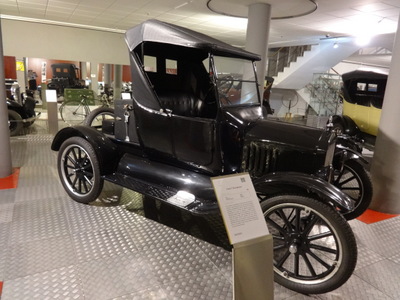
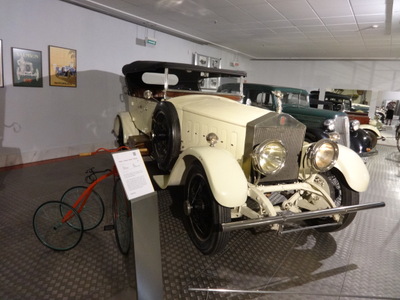 Here, at the left is a Ford model T "runabout," and at the right a Rolls Royce Silver Ghost.
Here, at the left is a Ford model T "runabout," and at the right a Rolls Royce Silver Ghost.
The museum's current special exhibition was of American cars from the 1960s and 1970s, the era of fin-bedecked highway barges. One of their smaller specimens was a 1954 Ford Fairlane just like the one I drove for a while in highschool. I was particularly taken with a Lincoln Continental that had tailfins not only on the rear fenders but on the front ones as well. Bob Hayward, you need to visit this place!
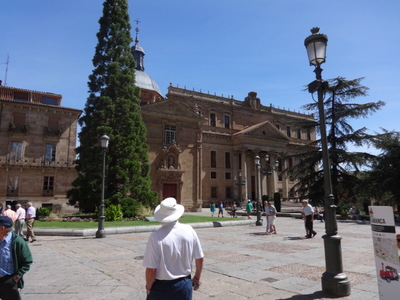
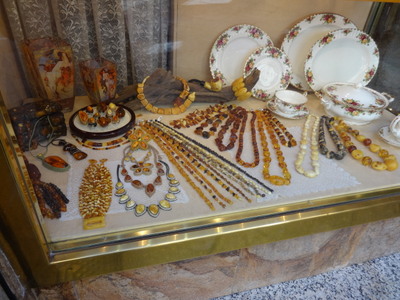 At lunch time, we strolled back up through the center of town to the Palace Hotel to rejoin the rest of the group. On the way, we passed through both grand squares, like the one shown here at the left, and smaller shopping streets. I think the cathedral was right behind me when I took the photo of the square.
At lunch time, we strolled back up through the center of town to the Palace Hotel to rejoin the rest of the group. On the way, we passed through both grand squares, like the one shown here at the left, and smaller shopping streets. I think the cathedral was right behind me when I took the photo of the square.
At the right is a shop window featuring amber jewelry.
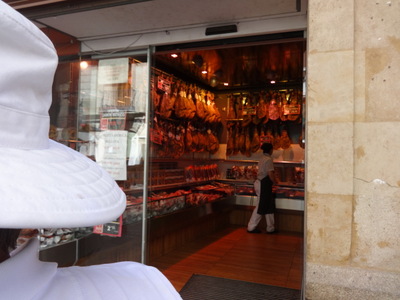
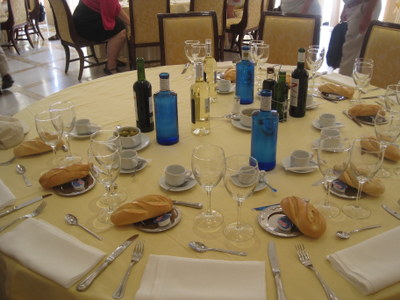 At the left here is the view in through the door of a shop selling whole hams, hung all around the upper walls, as well as smaller cuts, hocks, and packages of slices.
At the left here is the view in through the door of a shop selling whole hams, hung all around the upper walls, as well as smaller cuts, hocks, and packages of slices.
Back at the hotel, we were seated in the ballroom for a buffet lunch. At the right here is our table, set with bread buns (on little silver plates, each with its individual little plastic tub of butter, demitasse cups, bottles of red and white wine, a little bowl of green olives, bottles of oil and vinegar, and blue bottles of chilled water.

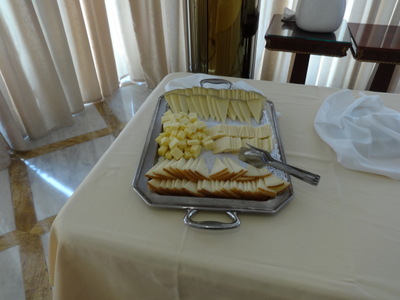 At the left here is the tapas buffet that served as the appetizer course—a sort of salad bar that included tuna, eggs, and corn as well as greens and many sliced vegetables.
At the left here is the tapas buffet that served as the appetizer course—a sort of salad bar that included tuna, eggs, and corn as well as greens and many sliced vegetables.
Next was a platter of Spanish cheese, prominently featuring Manchego, of course. Then a huge pot of paella, being doled out by servers, and Spanish tortilla, which is a round cake of onions and potatoes cooked in olive oil held together with a little beaten egg (we'd had that many times before, as it has become a staple of breakfast buffets all over the south of France).
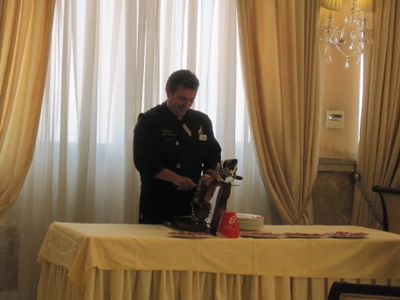
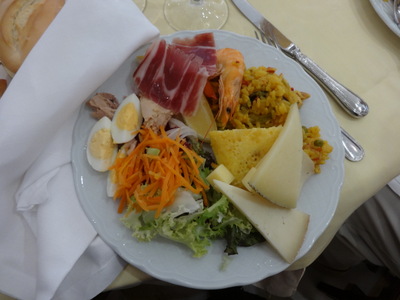 While we were serving ourselves at the buffet, a professional "cortador" (a "carver") was slicing a whole Iberian ham into wafer-thin slices, plates of which were placed on each table.
While we were serving ourselves at the buffet, a professional "cortador" (a "carver") was slicing a whole Iberian ham into wafer-thin slices, plates of which were placed on each table.
At the right is my first plate. Clockwise from 7 o'clock: salad with eggs and tuna, slices of Iberian ham, a prawn and mound of paella, wedges of Manchego and little cubes of some other cheese, not labeled. To the left of the cheese is a wedge of Spanish tortilla.
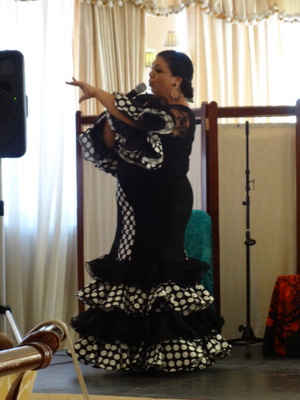
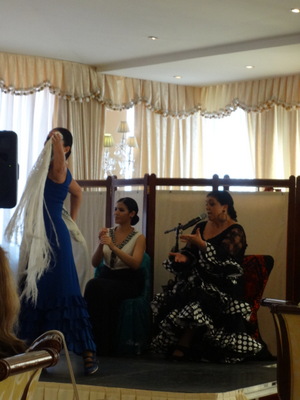 While we ate, we were entertained by a trio of women, who could easily have been grandmother, mother, and daughter, singing and dancing flamenco.
While we ate, we were entertained by a trio of women, who could easily have been grandmother, mother, and daughter, singing and dancing flamenco.
The grandmother did most of the singing, but did some pretty impressive dancing as well. They went through several styles, although without explanations. Castanets came and went, and they went through many costume changes, taking turns performing while the others changed behind the white screen that served as a backdrop to the stage.
Of course I have no basis for comparison, never having witnessed live flamenco before, but they seemed very good to me, and we enjoyed the show a lot, whereas the lunch was only so-so. And just to put the crowning touch on it, when the guy next to me sat down at the table, a leg fell off his chair, dumping him on the floor. They had to go find another chair somewhere.
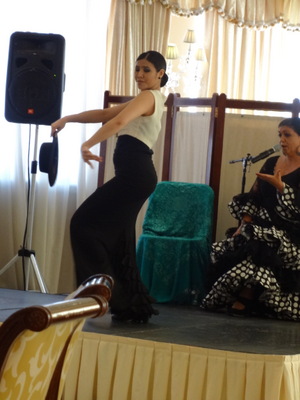
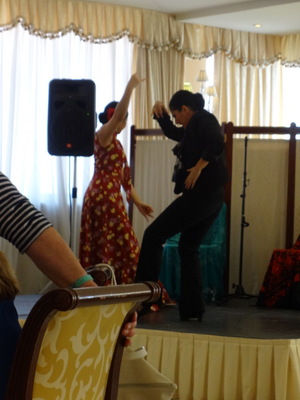 The mother came down from the stage and roamed among our tables during some of her dance numbers.
The mother came down from the stage and roamed among our tables during some of her dance numbers.
For the final series of dance numbers, the mother and daughter danced together, and the mother wore trousers, presumably dancing the male partner's part. I had a lot of trouble capturing the athleticism of the dancing in my photos, and I wish I could have recorded the songs, which were great.
These ladies must show up and do their routine every Thursday, for successive busloads of Viking cruisers, but like the Viking staff, they do a good job of maintaining the enthusiasm and making each group feel like they're the first.
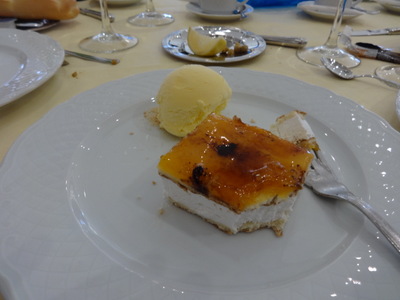
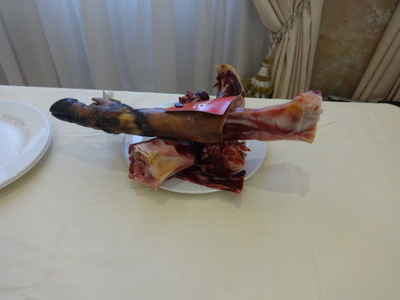 During the show, we were served torta de San Marcos, a dessert consisting of a layer of marshmallow fluff between two layers of crumbs and topped with a shiny apricot-colored glaze. Unfortunately, the whole thing was pretty tasteless, but the orange sorbet served with it was good.
During the show, we were served torta de San Marcos, a dessert consisting of a layer of marshmallow fluff between two layers of crumbs and topped with a shiny apricot-colored glaze. Unfortunately, the whole thing was pretty tasteless, but the orange sorbet served with it was good.
The cortador finished his work and departed, leaving at his station only this neat pile of entirely bare ham bones. The ham, of course, was great.
Viking thinks of everything, so we had been warned our arrival in town that Salamanca provides no public restrooms and that we should therefore take advantage of the hotel and the museums. The hotel restrooms were entirely mirrored, inside and outside the stalls, making it a little hard to find your way out!

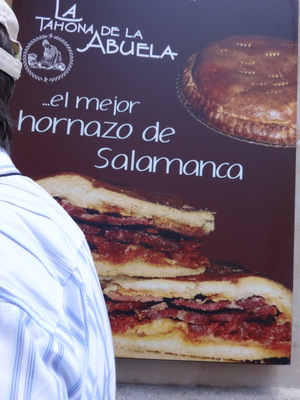 After lunch, we walked back down, through more shopping streets, to meet our guide for the afternoon walking tour. At the left here is a window displaying simple baguette sandwiches of the wonderful local ham. To the left of the sandwiches is a small pile of "hornazo," a very popular local specialty. A hornazo is a sort of flat bread-crusted pie like a calzone. They were mostly round or square and came in sizes from saucer to man-hole cover. The sign in this window says "hornazo by weight" and gives a price per kilo.
After lunch, we walked back down, through more shopping streets, to meet our guide for the afternoon walking tour. At the left here is a window displaying simple baguette sandwiches of the wonderful local ham. To the left of the sandwiches is a small pile of "hornazo," a very popular local specialty. A hornazo is a sort of flat bread-crusted pie like a calzone. They were mostly round or square and came in sizes from saucer to man-hole cover. The sign in this window says "hornazo by weight" and gives a price per kilo.
The poster in the right-hand photo shows wedges of hornazo, labeled "the best in Salamanca." They come with a variety of fillings, the most popular of which are combinations of sausage, ham, tomatoes, tuna, and eggs.
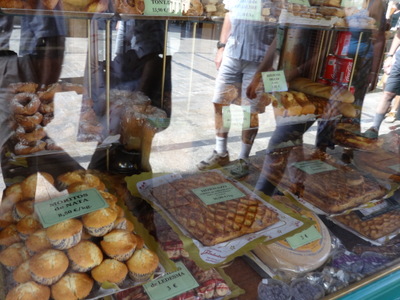
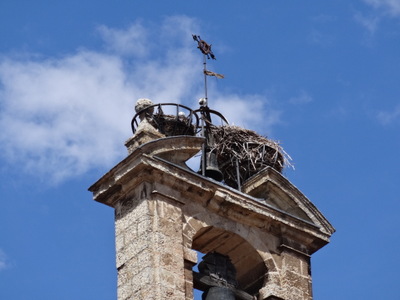 In the window shown at the left here, the large rectangular hornazo in the center is marked at almost twice the price per kilo as the one above—maybe it includes more expensive fillings. To its left are cream cupcakes. I don't know why the similar flat rectangular pie to its right is labeled an "empanada" rather than "hornazo"—perhaps the bread coverings of the two are different in some way. "Hornazo" means "oven baked," whereas "empanada" means "covered in bread."
In the window shown at the left here, the large rectangular hornazo in the center is marked at almost twice the price per kilo as the one above—maybe it includes more expensive fillings. To its left are cream cupcakes. I don't know why the similar flat rectangular pie to its right is labeled an "empanada" rather than "hornazo"—perhaps the bread coverings of the two are different in some way. "Hornazo" means "oven baked," whereas "empanada" means "covered in bread."
The photo to the right shows a stork's nest on top of the bell tower of the church of St. Martin. Special metal baskets are provided to help and encourage the storks to nest there. The church is named for the French St. Martin; this was the French quarter of the town.
As we walked, I also discovered that, at crosswalks in Salamanca, not only are the green walking men (the signals indicating that it's safe to cross) animated, they speed up when the count gets low. That is, they don't just stand there in walking position but scissor their legs in a walking motion, then start hurrying as crossing time gets short!
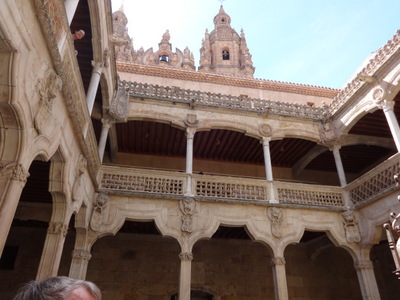
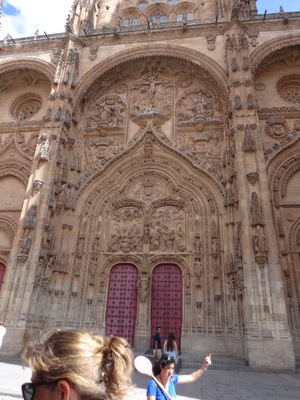 Our locally certified city guide for the walking tour was Maria. She took us through several enclosed squares of historical interest (though I confess I couldn't keep them all straight), including the one shown here at the left. The railing of the upper level is particularly elaborately carved. Its horizontal elements repesent thorny vines woven in and out of the straight vertical posts.
Our locally certified city guide for the walking tour was Maria. She took us through several enclosed squares of historical interest (though I confess I couldn't keep them all straight), including the one shown here at the left. The railing of the upper level is particularly elaborately carved. Its horizontal elements repesent thorny vines woven in and out of the straight vertical posts.
At the right is the facade of the cathedral, Saint Basil's. That's Maria at the bottom in the blue shirt, with the Viking lollipop sign over her shoulder. This distant photo gives the general effect but in no way captures the intricate detail of, e.g., the Bible scenes carved over the doorway.
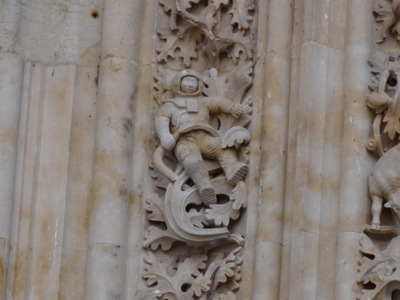
 Around the corner, near a side door of the cathedral, I was able to photograph this detail of the carving, about six feet off the ground. The carvings in this area had been damaged, and when the restoration was done, the stone masons took the liberty of including a little modern imagery, like this astronaut in a space suit!
Around the corner, near a side door of the cathedral, I was able to photograph this detail of the carving, about six feet off the ground. The carvings in this area had been damaged, and when the restoration was done, the stone masons took the liberty of including a little modern imagery, like this astronaut in a space suit!
As you can see in the right-hand photo, the inside of the cathedral is also elaborately decorated with stone carving. This is the interior of the new cathedral.
The cathedral tower almost fell in the Lisbon earthquake of 1755 ("New" Cathedral" is a relative term). The lower three layers had to be reinforced, hence the slabsided look of that section. Today, jackdaws nest in the tower.

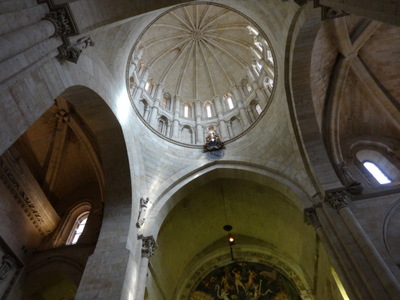 Through an opening in the side of the new cathedral, you can enter the old, smaller cathedral that it replaced, where some of the original polychrome decor is preserved. It also houses a charming little wooden 16th century organ.
Through an opening in the side of the new cathedral, you can enter the old, smaller cathedral that it replaced, where some of the original polychrome decor is preserved. It also houses a charming little wooden 16th century organ.
Written 11 May 2016
You can be married in either the new or the old cathedral, but doing so involves a two-year waiting period and a stiff fee, so brides tend to book the cathedral, then look for a groom.
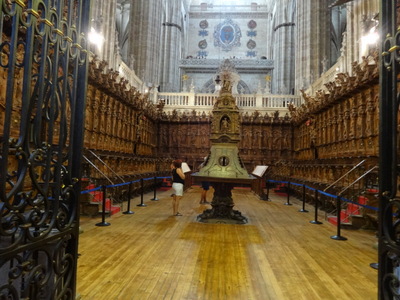
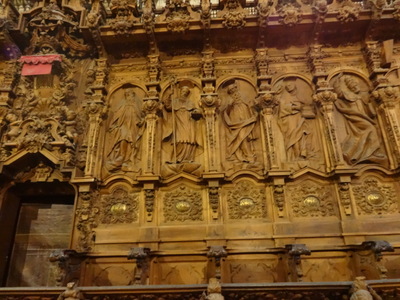 The cathedral's choir stalls are elaborately carved, as you can see in long view at the left and a little more detail at the right.
The cathedral's choir stalls are elaborately carved, as you can see in long view at the left and a little more detail at the right.
Salamanca was built of Villa Mayora sandstone, which turns golden with age as bits of iron trapped in the stone oxidize over time. Very little of the original quarry is left, so it is now used very sparingly.
The Celts were in Salamanca 500 years BC. Then the Romans arrived in the first century AD. In 1218, the university was founded; it's the oldest in Spain and third oldest in the world. The city has 170,000 inhabitants and 65,000 students, of whom 17,000 are foreign students. (Kathy immediately decided she wants to come back for a semester.)
The city's main square was built in the 18th century. It comprises 88 arches, each decorated with a medallion. Each medallion bears a labeled portrait of somebody famous. On the east side (the royal pavillion) they all portray royalty, plus Franco (who took down somebody else to put himself up). The south side portrays "heros" (explorers, Columbus, Cortez, Pizarro, etc.), the west side shows university professors, including Cervantes, even Wellington. The north, the last to be built, is the town hall. Some medallions have been left empty, to accommodate future famous people. The lower floor is full of bars and restaurants; the rest is private apartments, most empty because they're very expensive and very noisy. The bull on top of the flagpole on city hall means the city's annual festivities are coming soon. (Driving out of town later, we saw illuminated Christmas-style decorations over the streets, but with a bull in the center.)
Maria also pointed out a statue of Maestro Salina, a 16th century blind professor of music.
A personage named Maldovado built what is now called the house of shells—the shell was the symbol of his family. More than 300 carved stone seashells decorate the facade, and in the entrance hall hangs a giant chandelier made of real shells. The building is now the public library, but vestiges of its original fortifications ar still evident: an offset double front door, loopholes into the inner courtyard, and a very narrow spiral staircase that didn't allow a swordsman room to swing while people above threw things down on him. I think the photo above with the woven-vine railing may be of the inner courtyard of the House of Shells.
Finally, we toured the university. It was long the university of Spain, and everyone went there. For example, Columbus was student in Salamanca. It was the first university that taught music and the first to allow students to read in Hebrew and Arabic as well as Chistian literature.
Students had servants, sometimes as many as 20 (they were mostly noblemen). Classrooms were small and cold and had stone floors, where the students sat, so some sent servants ahead to sit in their spots and warm them ahead of time. Some of the students actually worked their way through as servants to wealthier students. A separate college was built to accommodate poor students, sort of like the co-op houses at modern liberal-arts colleges.
Students challenged each other to sword duals right up into the 19th century. Weapons were forbidden, but everyone wore long black robes, so enforcement was a problem. They fought to drawn blood and sometimes even to the death.
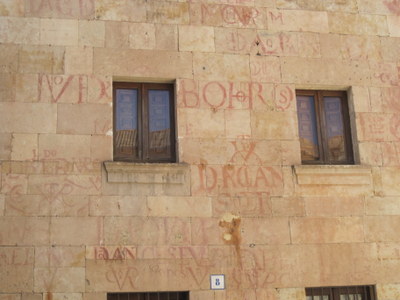
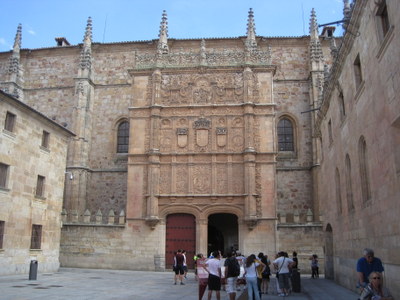 Each doctoral student spent the night before his defense locked in the cathedral, to study and pray, then was exmained in there in the morning. Successful ones then had to throw a three-day party for the professors and everyone else, including a bullfight. The bull was roasted on the last day, and the student was entitled to use its blood to write a message of victory on any public monument. A flat wall of the cathedral is covered with them. The city adds modern ones to commemorate state visits, etc., and many shops write their signs to resemble them. (I don't know whether they still use actual blood.)
Each doctoral student spent the night before his defense locked in the cathedral, to study and pray, then was exmained in there in the morning. Successful ones then had to throw a three-day party for the professors and everyone else, including a bullfight. The bull was roasted on the last day, and the student was entitled to use its blood to write a message of victory on any public monument. A flat wall of the cathedral is covered with them. The city adds modern ones to commemorate state visits, etc., and many shops write their signs to resemble them. (I don't know whether they still use actual blood.)
The building shown at the right is the main university building. It's facade shows Isabella and Ferdinand in a medallion on the lower level, Charles their grandson above, then the pope talking to somebody at the top. Hidden amidst it's elaborate carvings is a skull with a little carved frog sitting on top. It was originally supposed to be a symbol of earthly lust (the frog) and its consequences (death and decay), put there as a dire warning to students, but it has since become the symbol of Salamanca. Supposedly, anyone who can spot it unaided will pass all his exams successfully (or simply be followed by good luck if not student), so droves of tourists and students are always staring at the carvings, looking for the frog. Meanwhile, hundreds of souvenir shops throughout the city sell frog figurines of all sizes and shapes. Some are replicas of the original—life-size skulls with realistic stone frogs on top—but most are garishly colored, anthropomorphized cartoon frogs, leering, winking, giving thumbs up, wearing baseball caps or mortarboards, etc. We spotted the frog, but only with help from Maria.
After a little free time, to be spent shopping for hornazo, frogs, postcards, etc., we returned at the appointed hour of 4:10 p.m. to the rendezvouz point and boarded our buses for the trip back to the ship.

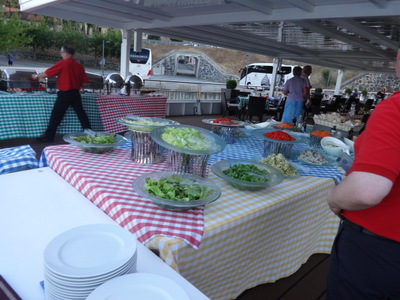 On our way out of town, we passed (as we had on our way in) the giant UNESCO symbol, marking the city as a World Heritage Site. Behind me as I took the photo was the River Tormes, crossed by an original stone Roman bridge guarded by a headless stone bull.
On our way out of town, we passed (as we had on our way in) the giant UNESCO symbol, marking the city as a World Heritage Site. Behind me as I took the photo was the River Tormes, crossed by an original stone Roman bridge guarded by a headless stone bull.
After retracing our route across the Spanish plateau (during which I learned that the lady across the aisle from us on the bus is the grandmother of America's premiere exporter of eels), we arrived back aboard the Hemming to find that the kitchen crew had spent the day moving their entire operation to the open top deck to stage a cookout! Gone were the formal jackets and ties; the uniform of the day for officers and wait staff alike was the bright red Viking t-shirt.
The right-hand photo shows the salad and appetizer buffet. In the background, I'm pretty sure that's Joaquim, the ship's hotel manager, tending the chafing dishes.
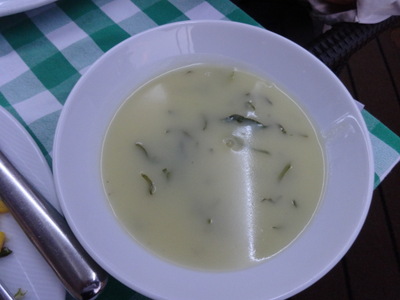
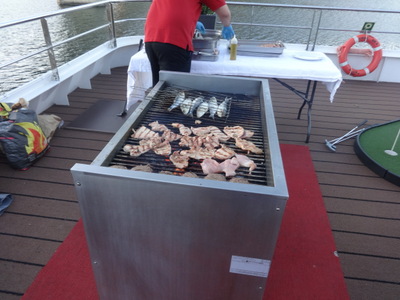 While we found seats at the tables under the large shade canopy (draped with checked tablecloths in a variety of colors), helped ourselves to the buffet, and then to this potato and kale soup, the kitchen staff tended giant grills.
While we found seats at the tables under the large shade canopy (draped with checked tablecloths in a variety of colors), helped ourselves to the buffet, and then to this potato and kale soup, the kitchen staff tended giant grills.
Heaven forbid there shouldn't be enough variety, so all the things that the Portuguese traditionaly grill were there, sizzling away.
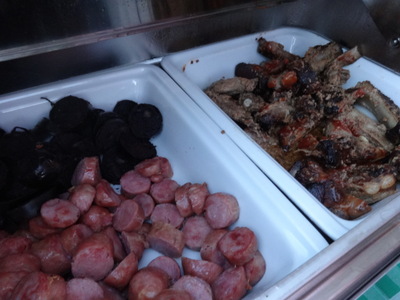
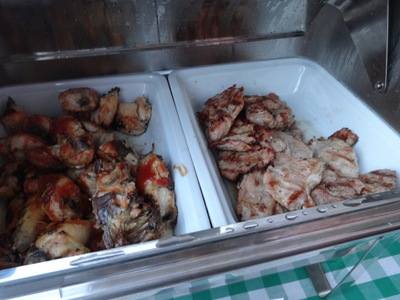 At the left here, in covered warming trays, are chunks of two kinds of sausages—pink linguica and black blood sausage— and in the adjacent dish, short ribs, cut into easily served and eaten pieces.
At the left here, in covered warming trays, are chunks of two kinds of sausages—pink linguica and black blood sausage— and in the adjacent dish, short ribs, cut into easily served and eaten pieces.
In the right-hand phoito are grilled chicken thighs with a drizzle of barbecue sauce and plain grilled boneless chicken breasts. Other dishes held fried potatoes, grilled salmon, and greens.
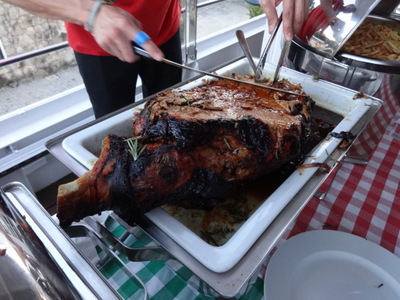
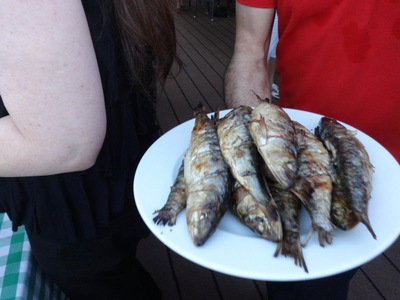 At the carving station was this magnificent whole roasted leg of pork, strewn with rosemary sprigs. The carver basted each slice as he served it with the rich roasting juices in the pan.
At the carving station was this magnificent whole roasted leg of pork, strewn with rosemary sprigs. The carver basted each slice as he served it with the rich roasting juices in the pan.
And finally, the Portuguese grilled food par excellence: whole fresh sardines. This was a dish I had been anxious to try, but I was disappointed in these. First, they really were whole, right out of the water, scales entrails and all. After getting a mouthful of scales on the first try, I scraped the skin off (too bad; I love the crispy grilled skin of scaled fish) and tried the flesh. Alas it was firm to hardness and had almost a bitter taste. Portuguese friends tell me they shouldn't be like that, so I'll reserve judgement until I get a chance to try some that weren't being prepared in mass quantitites.
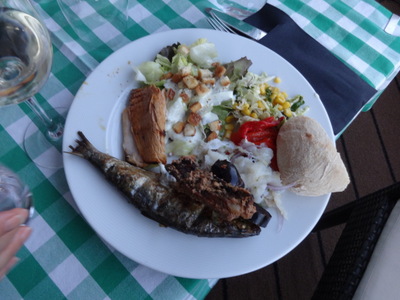
 At the left here is my first plate. Clockwise from the top: salad with croutons and a creamy dressing, salad of corn and cheese, strips of roasted red pepper, a pale crusty bread bun, cod salad (shreds of reconsituted dried salt cod with slivers of onion), a couple chunks of blood sausage with a rib on top, a grilled sardine, and a slice of roast pork.
At the left here is my first plate. Clockwise from the top: salad with croutons and a creamy dressing, salad of corn and cheese, strips of roasted red pepper, a pale crusty bread bun, cod salad (shreds of reconsituted dried salt cod with slivers of onion), a couple chunks of blood sausage with a rib on top, a grilled sardine, and a slice of roast pork.
The right-hand photo shows some of the desserts: an assortment of flans, cakes, and tortes.
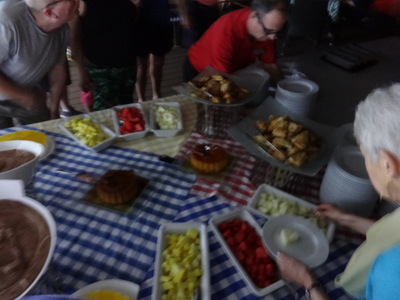
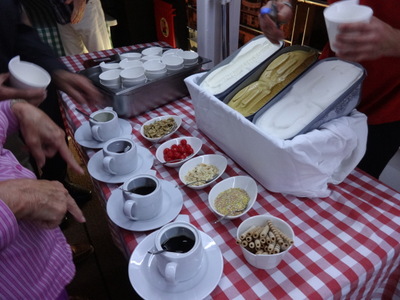 Dessert also included big bowls of chocolate mousse (just visible at the left-hand edge of the photo) and bowls of melon, pineapple, and berries.
Dessert also included big bowls of chocolate mousse (just visible at the left-hand edge of the photo) and bowls of melon, pineapple, and berries.
Finally, three flavors of ice cream were accompanied by a variety of sauces and toppings for make-it-yourself sundaes!
All this was followed, as dinner was on most evenings, by music and dancing in the lounge.
 In lieu of sunset shot, here's the view of the river from the deck during the cookout.
In lieu of sunset shot, here's the view of the river from the deck during the cookout.
Previous entry
List of Entries
Next entry

 We passed this railway bridge as we left the river, but by the time we were half an hour into Spain, we saw no more olives or almonds, just pasture-land with a few scattered oaks (as shown at the right; the fields were level; only the camera was tilted), recently harvested hay fields, and some plowed fields. The land was a high, flat pleateau.
We passed this railway bridge as we left the river, but by the time we were half an hour into Spain, we saw no more olives or almonds, just pasture-land with a few scattered oaks (as shown at the right; the fields were level; only the camera was tilted), recently harvested hay fields, and some plowed fields. The land was a high, flat pleateau.
 In Salamanca, our free time was before lunch, so we headed for the Lis Museum of Art Nouveau and Art Deco, which was wonderful but was among that annoying class of museums that forbid indoor photography. These shots are the best I could do. A good point is that state-owned museums are free on Thursdays, which is why Viking timed our visit as it did.
In Salamanca, our free time was before lunch, so we headed for the Lis Museum of Art Nouveau and Art Deco, which was wonderful but was among that annoying class of museums that forbid indoor photography. These shots are the best I could do. A good point is that state-owned museums are free on Thursdays, which is why Viking timed our visit as it did.
 At the left here is the view of the museum from the back, showing another magnificent spread of art nouveau windows.
At the left here is the view of the museum from the back, showing another magnificent spread of art nouveau windows.
 After the Lis museum, we walked down the street you can see in the photo above to the Automobile Museum, which displayed dozens of vehicles like these.
After the Lis museum, we walked down the street you can see in the photo above to the Automobile Museum, which displayed dozens of vehicles like these. 
 The displays actually started with forerunners of the automobile, like cycles of various sorts. At the left here is a wooden vehicle that the rider powered by turning a wooden crank from the driver's seat that by means of the rope pulleys and gears, turned the wheels. Near it was a small scale model of another wooden vehicle intended to be driven by wind—not by sails but by windmills mounted on the side like paddle-wheels!
The displays actually started with forerunners of the automobile, like cycles of various sorts. At the left here is a wooden vehicle that the rider powered by turning a wooden crank from the driver's seat that by means of the rope pulleys and gears, turned the wheels. Near it was a small scale model of another wooden vehicle intended to be driven by wind—not by sails but by windmills mounted on the side like paddle-wheels!
 Here are two of the earliest motorized vehicles, a modified tricycle at the left (a Benz, no less) and a version at the right that has two seats and hinges in the middle, though it still has only three wheels. It seems to be based more on the model of a carriage or wagon and less on that of a three-wheeled cycle.
Here are two of the earliest motorized vehicles, a modified tricycle at the left (a Benz, no less) and a version at the right that has two seats and hinges in the middle, though it still has only three wheels. It seems to be based more on the model of a carriage or wagon and less on that of a three-wheeled cycle.
 Here, at the left is a Ford model T "runabout," and at the right a Rolls Royce Silver Ghost.
Here, at the left is a Ford model T "runabout," and at the right a Rolls Royce Silver Ghost.
 At lunch time, we strolled back up through the center of town to the Palace Hotel to rejoin the rest of the group. On the way, we passed through both grand squares, like the one shown here at the left, and smaller shopping streets. I think the cathedral was right behind me when I took the photo of the square.
At lunch time, we strolled back up through the center of town to the Palace Hotel to rejoin the rest of the group. On the way, we passed through both grand squares, like the one shown here at the left, and smaller shopping streets. I think the cathedral was right behind me when I took the photo of the square.
 At the left here is the view in through the door of a shop selling whole hams, hung all around the upper walls, as well as smaller cuts, hocks, and packages of slices.
At the left here is the view in through the door of a shop selling whole hams, hung all around the upper walls, as well as smaller cuts, hocks, and packages of slices.
 At the left here is the tapas buffet that served as the appetizer course—a sort of salad bar that included tuna, eggs, and corn as well as greens and many sliced vegetables.
At the left here is the tapas buffet that served as the appetizer course—a sort of salad bar that included tuna, eggs, and corn as well as greens and many sliced vegetables.
 While we were serving ourselves at the buffet, a professional "cortador" (a "carver") was slicing a whole Iberian ham into wafer-thin slices, plates of which were placed on each table.
While we were serving ourselves at the buffet, a professional "cortador" (a "carver") was slicing a whole Iberian ham into wafer-thin slices, plates of which were placed on each table. 
 While we ate, we were entertained by a trio of women, who could easily have been grandmother, mother, and daughter, singing and dancing flamenco.
While we ate, we were entertained by a trio of women, who could easily have been grandmother, mother, and daughter, singing and dancing flamenco. 
 The mother came down from the stage and roamed among our tables during some of her dance numbers.
The mother came down from the stage and roamed among our tables during some of her dance numbers. 
 During the show, we were served torta de San Marcos, a dessert consisting of a layer of marshmallow fluff between two layers of crumbs and topped with a shiny apricot-colored glaze. Unfortunately, the whole thing was pretty tasteless, but the orange sorbet served with it was good.
During the show, we were served torta de San Marcos, a dessert consisting of a layer of marshmallow fluff between two layers of crumbs and topped with a shiny apricot-colored glaze. Unfortunately, the whole thing was pretty tasteless, but the orange sorbet served with it was good.
 After lunch, we walked back down, through more shopping streets, to meet our guide for the afternoon walking tour. At the left here is a window displaying simple baguette sandwiches of the wonderful local ham. To the left of the sandwiches is a small pile of "hornazo," a very popular local specialty. A hornazo is a sort of flat bread-crusted pie like a calzone. They were mostly round or square and came in sizes from saucer to man-hole cover. The sign in this window says "hornazo by weight" and gives a price per kilo.
After lunch, we walked back down, through more shopping streets, to meet our guide for the afternoon walking tour. At the left here is a window displaying simple baguette sandwiches of the wonderful local ham. To the left of the sandwiches is a small pile of "hornazo," a very popular local specialty. A hornazo is a sort of flat bread-crusted pie like a calzone. They were mostly round or square and came in sizes from saucer to man-hole cover. The sign in this window says "hornazo by weight" and gives a price per kilo.
 In the window shown at the left here, the large rectangular hornazo in the center is marked at almost twice the price per kilo as the one above—maybe it includes more expensive fillings. To its left are cream cupcakes. I don't know why the similar flat rectangular pie to its right is labeled an "empanada" rather than "hornazo"—perhaps the bread coverings of the two are different in some way. "Hornazo" means "oven baked," whereas "empanada" means "covered in bread."
In the window shown at the left here, the large rectangular hornazo in the center is marked at almost twice the price per kilo as the one above—maybe it includes more expensive fillings. To its left are cream cupcakes. I don't know why the similar flat rectangular pie to its right is labeled an "empanada" rather than "hornazo"—perhaps the bread coverings of the two are different in some way. "Hornazo" means "oven baked," whereas "empanada" means "covered in bread."
 Our locally certified city guide for the walking tour was Maria. She took us through several enclosed squares of historical interest (though I confess I couldn't keep them all straight), including the one shown here at the left. The railing of the upper level is particularly elaborately carved. Its horizontal elements repesent thorny vines woven in and out of the straight vertical posts.
Our locally certified city guide for the walking tour was Maria. She took us through several enclosed squares of historical interest (though I confess I couldn't keep them all straight), including the one shown here at the left. The railing of the upper level is particularly elaborately carved. Its horizontal elements repesent thorny vines woven in and out of the straight vertical posts. 
 Around the corner, near a side door of the cathedral, I was able to photograph this detail of the carving, about six feet off the ground. The carvings in this area had been damaged, and when the restoration was done, the stone masons took the liberty of including a little modern imagery, like this astronaut in a space suit!
Around the corner, near a side door of the cathedral, I was able to photograph this detail of the carving, about six feet off the ground. The carvings in this area had been damaged, and when the restoration was done, the stone masons took the liberty of including a little modern imagery, like this astronaut in a space suit!
 Through an opening in the side of the new cathedral, you can enter the old, smaller cathedral that it replaced, where some of the original polychrome decor is preserved. It also houses a charming little wooden 16th century organ.
Through an opening in the side of the new cathedral, you can enter the old, smaller cathedral that it replaced, where some of the original polychrome decor is preserved. It also houses a charming little wooden 16th century organ.
 The cathedral's choir stalls are elaborately carved, as you can see in long view at the left and a little more detail at the right.
The cathedral's choir stalls are elaborately carved, as you can see in long view at the left and a little more detail at the right.
 Each doctoral student spent the night before his defense locked in the cathedral, to study and pray, then was exmained in there in the morning. Successful ones then had to throw a three-day party for the professors and everyone else, including a bullfight. The bull was roasted on the last day, and the student was entitled to use its blood to write a message of victory on any public monument. A flat wall of the cathedral is covered with them. The city adds modern ones to commemorate state visits, etc., and many shops write their signs to resemble them. (I don't know whether they still use actual blood.)
Each doctoral student spent the night before his defense locked in the cathedral, to study and pray, then was exmained in there in the morning. Successful ones then had to throw a three-day party for the professors and everyone else, including a bullfight. The bull was roasted on the last day, and the student was entitled to use its blood to write a message of victory on any public monument. A flat wall of the cathedral is covered with them. The city adds modern ones to commemorate state visits, etc., and many shops write their signs to resemble them. (I don't know whether they still use actual blood.)
 On our way out of town, we passed (as we had on our way in) the giant UNESCO symbol, marking the city as a World Heritage Site. Behind me as I took the photo was the River Tormes, crossed by an original stone Roman bridge guarded by a headless stone bull.
On our way out of town, we passed (as we had on our way in) the giant UNESCO symbol, marking the city as a World Heritage Site. Behind me as I took the photo was the River Tormes, crossed by an original stone Roman bridge guarded by a headless stone bull.
 While we found seats at the tables under the large shade canopy (draped with checked tablecloths in a variety of colors), helped ourselves to the buffet, and then to this potato and kale soup, the kitchen staff tended giant grills.
While we found seats at the tables under the large shade canopy (draped with checked tablecloths in a variety of colors), helped ourselves to the buffet, and then to this potato and kale soup, the kitchen staff tended giant grills.
 At the left here, in covered warming trays, are chunks of two kinds of sausages—pink linguica and black blood sausage— and in the adjacent dish, short ribs, cut into easily served and eaten pieces.
At the left here, in covered warming trays, are chunks of two kinds of sausages—pink linguica and black blood sausage— and in the adjacent dish, short ribs, cut into easily served and eaten pieces.
 At the carving station was this magnificent whole roasted leg of pork, strewn with rosemary sprigs. The carver basted each slice as he served it with the rich roasting juices in the pan.
At the carving station was this magnificent whole roasted leg of pork, strewn with rosemary sprigs. The carver basted each slice as he served it with the rich roasting juices in the pan.
 At the left here is my first plate. Clockwise from the top: salad with croutons and a creamy dressing, salad of corn and cheese, strips of roasted red pepper, a pale crusty bread bun, cod salad (shreds of reconsituted dried salt cod with slivers of onion), a couple chunks of blood sausage with a rib on top, a grilled sardine, and a slice of roast pork.
At the left here is my first plate. Clockwise from the top: salad with croutons and a creamy dressing, salad of corn and cheese, strips of roasted red pepper, a pale crusty bread bun, cod salad (shreds of reconsituted dried salt cod with slivers of onion), a couple chunks of blood sausage with a rib on top, a grilled sardine, and a slice of roast pork.
 Dessert also included big bowls of chocolate mousse (just visible at the left-hand edge of the photo) and bowls of melon, pineapple, and berries.
Dessert also included big bowls of chocolate mousse (just visible at the left-hand edge of the photo) and bowls of melon, pineapple, and berries.